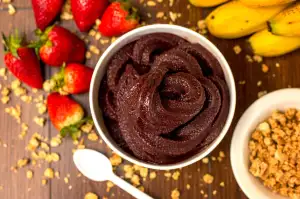Spice up Your Recipes with Gochujang Sauce: A Fiery Korean Delight

Gochujang sauce is a fiery and flavorful condiment that originates from Korea. It is known for its vibrant red color and intense spiciness, making it a favorite among spice lovers. This versatile sauce adds a unique depth of flavor to any dish, whether it's used as a marinade, dipping sauce, or even as a base for soups and stews. If you're looking to add some heat and excitement to your recipes, Gochujang sauce is the perfect ingredient to turn up the heat in your kitchen.
History and Origin of Gochujang Sauce
Gochujang sauce, a fiery Korean delight, has a rich history and fascinating origin. This traditional Korean condiment dates back to the 18th century and is believed to have been developed in the region of Jeolla Province. Gochujang sauce was initially made by fermenting soybeans, red chili peppers, and glutinous rice powder. Its popularity quickly spread throughout Korea, becoming an essential ingredient in many Korean dishes. Today, gochujang sauce is not only cherished in Korea but also celebrated worldwide for its unique flavor and versatility.
Ingredients Required for Gochujang Sauce
To make Gochujang Sauce, you will need the following ingredients:
- 1 cup of Korean red pepper flakes (Gochugaru)
- 1 cup of fermented soybean paste (Doenjang)
- 1/4 cup of rice syrup or honey
- 2 tablespoons of sesame oil
- 2 tablespoons of minced garlic
- 2 tablespoons of soy sauce
- 1 tablespoon of rice vinegar
- 1 tablespoon of sugar
These ingredients can be easily found in Asian grocery stores or online. Make sure to use authentic Korean ingredients for an authentic taste.
Step-by-Step Instructions to Make Gochujang Sauce
1. Gather the ingredients: 1 cup of Korean red pepper flakes, 1 cup of glutinous rice powder, ½ cup of soybean paste, ¼ cup of salt, 2 tablespoons of sugar, and 2 cups of water.
2. In a large bowl, combine the red pepper flakes and water. Let it soak for about 20 minutes until the flakes soften.
3. Meanwhile, in a separate bowl, mix the glutinous rice powder with enough water to make a smooth paste.
4. In a saucepan over medium heat, add the soaked red pepper flakes along with the remaining water. Bring it to a boil and then reduce the heat to low.
5. Gradually add the rice paste into the saucepan while stirring continuously to avoid lumps.
6. Stir in the soybean paste, salt, and sugar until well combined.
7. Cook the mixture over low heat for about an hour or until it thickens to a desired consistency.
8. Remove from heat and let it cool completely before transferring it into a sterilized jar or container.
9. Store in the refrigerator for up to several months for optimal flavor.
10. Enjoy your homemade Gochujang sauce in various recipes to add a spicy kick and rich umami flavor!
Tips and Variations for Gochujang Sauce
- Adjust the spiciness level by adding more or less Gochujang paste.
- For a milder version, mix Gochujang sauce with mayonnaise or yogurt.
- Enhance the flavor by adding garlic, ginger, or sesame oil to the sauce.
- Experiment with different sweeteners like honey or brown sugar for a unique twist.
- Use Gochujang sauce as a marinade for meats or vegetables before grilling or roasting.
- Mix Gochujang sauce with soy sauce and vinegar for a delicious dipping sauce.
- Add Gochujang sauce to soups, stews, stir-fries, or even salad dressings for an extra kick of flavor.
Serving Suggestions for Gochujang Sauce
Gochujang sauce is a versatile condiment that can be used in a variety of dishes to add a spicy kick and depth of flavor. Here are some serving suggestions to make the most of this fiery Korean delight:
1. Dip: Use Gochujang sauce as a dip for vegetables, grilled meats, or even fried tofu. Its bold and tangy flavor will elevate any snack or appetizer.
2. Marinade: Marinate chicken, beef, or seafood in Gochujang sauce for a few hours before grilling or roasting. The sauce will infuse the meat with its rich flavors and create a deliciously spicy glaze.
3. Stir-fry: Add Gochujang sauce to your stir-fried vegetables or noodles for an extra punch of heat and umami. It pairs particularly well with mushrooms, bell peppers, and bok choy.
4. Dressing: Mix Gochujang sauce with soy sauce, sesame oil, and lime juice to create a zesty dressing for salads or slaws. Drizzle it over fresh greens or use it as a marinade for cucumber salad.
5. Topping: Sprinkle Gochujang sauce on top of your favorite pizza, tacos, or burgers to give them an unexpected twist. It adds depth of flavor and spiciness that will leave your taste buds wanting more.
Remember to start with small amounts of Gochujang sauce if you're not accustomed to spicy foods, as it can be quite hot. Experiment with different combinations and enjoy the unique flavors this fiery Korean delight has to offer!
Health Benefits of Gochujang Sauce
Gochujang sauce not only adds a fiery kick to your recipes, but it also offers several health benefits. Made from fermented soybeans, red chili peppers, and glutinous rice, this Korean delight is packed with nutrients. Gochujang sauce is rich in vitamins, minerals, and antioxidants that promote overall well-being. It contains capsaicin, which can boost metabolism and aid in weight loss. Additionally, the fermentation process increases the bioavailability of nutrients and promotes gut health. Gochujang sauce is also known for its anti-inflammatory properties and may help reduce the risk of chronic diseases. So go ahead and spice up your dishes with this flavorful sauce while reaping its numerous health benefits!
In conclusion, Gochujang sauce is a fiery and flavorful Korean delight that can spice up any recipe. With its rich history and unique blend of ingredients, it adds depth and complexity to dishes. Whether used as a marinade, dipping sauce, or condiment, Gochujang sauce is versatile and easy to incorporate into your cooking. Its health benefits, such as boosting metabolism and aiding digestion, make it even more appealing. So why not give Gochujang sauce a try and add some heat to your culinary adventures?
Published: 12. 01. 2024
Category: Recipes



